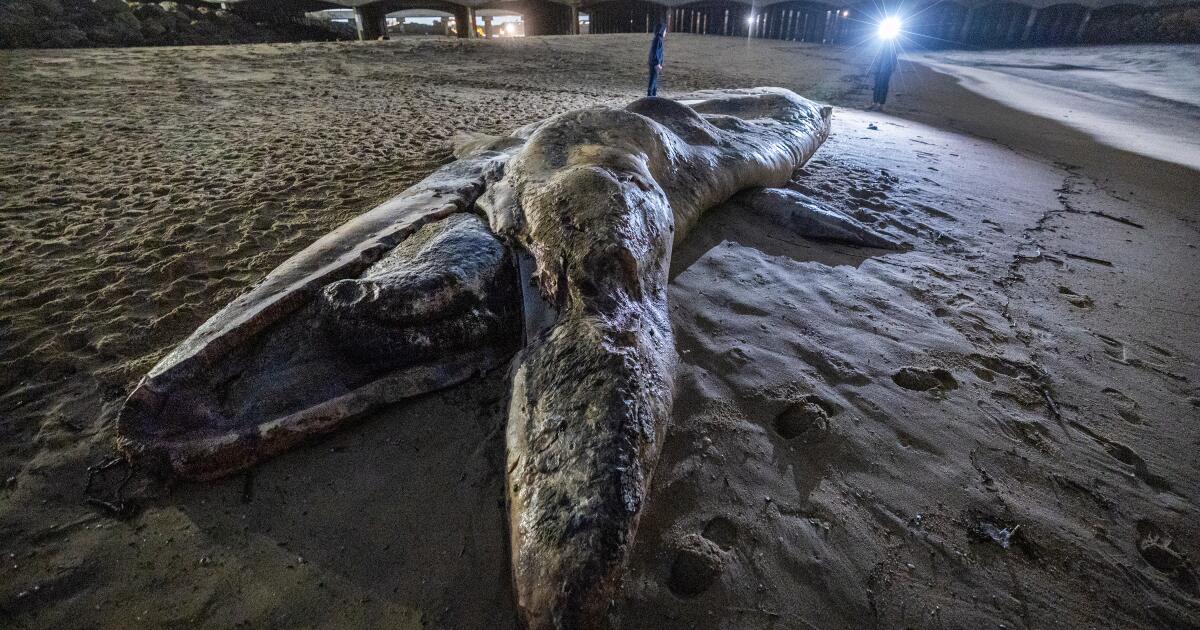The gray whale die-off on West Coast is over, NOAA declares
Between 2018 and 2023, hundreds of gray whale carcasses washed up along the West Coast. A food shortage led to the phenomenon, which is over, scientists say. The National Oceanic and Atmospheric Administration (NOAA Fisheries) has declared an "unusual mortality event" that led to hundreds of gray whale carcasses washing up on the West Coast shoreline. The cause was too little food available along its migratory route. Over the period of 2018 and 2023, carcasses from eastern North Pacific gray whales washed up from California to Alaska, with the highest number of whales stranded between December 2018 and December 2020. This contributed to a decline in the gray whale population to 14,526 in 2023 from 20,500 in 2019, amounting to a roughly 30% drop. Despite this decline, NOAA Fisheries noted promising signs of repopulation, including the doubling of the number of calves counted migrating north with their mothers.

Published : one year ago by Karen Garcia in Science
Janae Peterson takes a photo of her son, Desmond, 7, of Long Beach, as they view the carcass of a gray whale that washed ashore in Huntington Beach on Feb. 8, 2024.
The “unusual mortality event” that led to hundreds of gray whale carcasses washing up on the West Coast shoreline has ended, researchers say. The cause: too little food available along its epic migratory route.
Between 2018 and 2023, carcasses of eastern North Pacific gray whales washed up on coasts from California to Alaska, with the highest number of whales stranded between December 2018 and December 2020.
The National Oceanic and Atmospheric Administration, in consultation with the Working Group on Marine Mammal Unusual Mortality Events, opened its investigation into the unusual mortality event in 2019. Such an event, defined as an unexpected and significant die-off of any marine mammal population, requires immediate response under the Marine Mammal Protection Act.
In this case, the whale population and calf production showed significant signs of decline.
NOAA Fisheries — the agency responsible for stewarding ocean resources — and its partners determined that 690 gray whales washed ashore from 2018 to 2023: 347 in the United States, 316 in Mexico and 27 in Canada.
This contributed to the decline in the gray whale population to 14,526 in 2023 from 20,500 in 2019, NOAA said, amounting to a roughly 30% drop. Calf production totaled an estimated 217 in 2022, down from about 950 in 2018.
There are promising signs of repopulation, said Michael Milstein, a spokesman for NOAA. These include “the near-doubling of the number of calves counted migrating north with their mothers” last year.
The investigation found that the preliminary cause of the event was a number of changes in the local ecosystem, including changes to the sea ice cover and the supply of small organisms on the sea floor that the whales consume.
“Often they feed by diving to the bottom and sifting big gulps of sediment through their baleen, consuming the amphipods in great numbers,” Milstein said.
The whales migrate in the spring from the warm waters of Mexico’s Baja peninsula to the icy waters of the Arctic and sub-Arctic, where they feed until they return to Mexico in the fall to birth their calves.
A scientific journal published in 2022 reported a decrease in the ocean’s crustaceans in the northern Bering and Chukchi seas, leading to the gray whales’ malnutrition. A year later, another scientific study pointed to the food scarcity as one of the potential effects of climate change, saying the lack of sea ice is reducing the availability of the Arctic prey.
“This may help explain why many of the gray whales that stranded along the West Coast beginning in 2019 were skinny and emaciated — they had not eaten enough to support their long migration of about 10,000 miles round-trip, which is one of the longest known migrations of any animal,” Milstein said.
Killer whale predation, entanglement in fishing nets, biotoxins and collisions with vessels also contributed to the gray whale deaths. But these factors were not as significant as malnutrition, researchers said.
This kind of dramatic die-off also occurred between 1999 and 2000 and two other times in the early 1990s, said John Calambokidis, researching biologist and part of the group that investigated the recent unusual event. What he and other scientists found interesting, Calambokidis said, was the dramatic fluctuation in the gray whale population before the mortality event.
He said that when the whale population reaches the limits of the environment’s carrying capacity, there would be a decrease in the reproductive rate and a slight increase in the mortality rate that would bring the population to a plateau. Gray whales seem to have gone through these more dramatic vacillations, enduring three different periods of major mortalities and bouncing back before the most recent five-year event.
As gray whales recover to levels “that are near the limits of the food supply, then suddenly they become much more vulnerable to any fluctuations in that food supply,” Calambokidis said.
Milstein added that gray whales were hunted to near extinction during the whaling era, but with the protections of the Marine Mammal Protection Act and the Endangered Species Act, the animals have recovered to the point where they were removed from endangered species protection in 1994.
More recently, the agency noted that the startling number of strandings that spiked at the start of the unusual mortality event has since declined to annual numbers similar to those recorded before the event began.
A gray whale washed up ashore in Orange County on Feb. 8 and another in Malibu this month, ABC7 reported.
